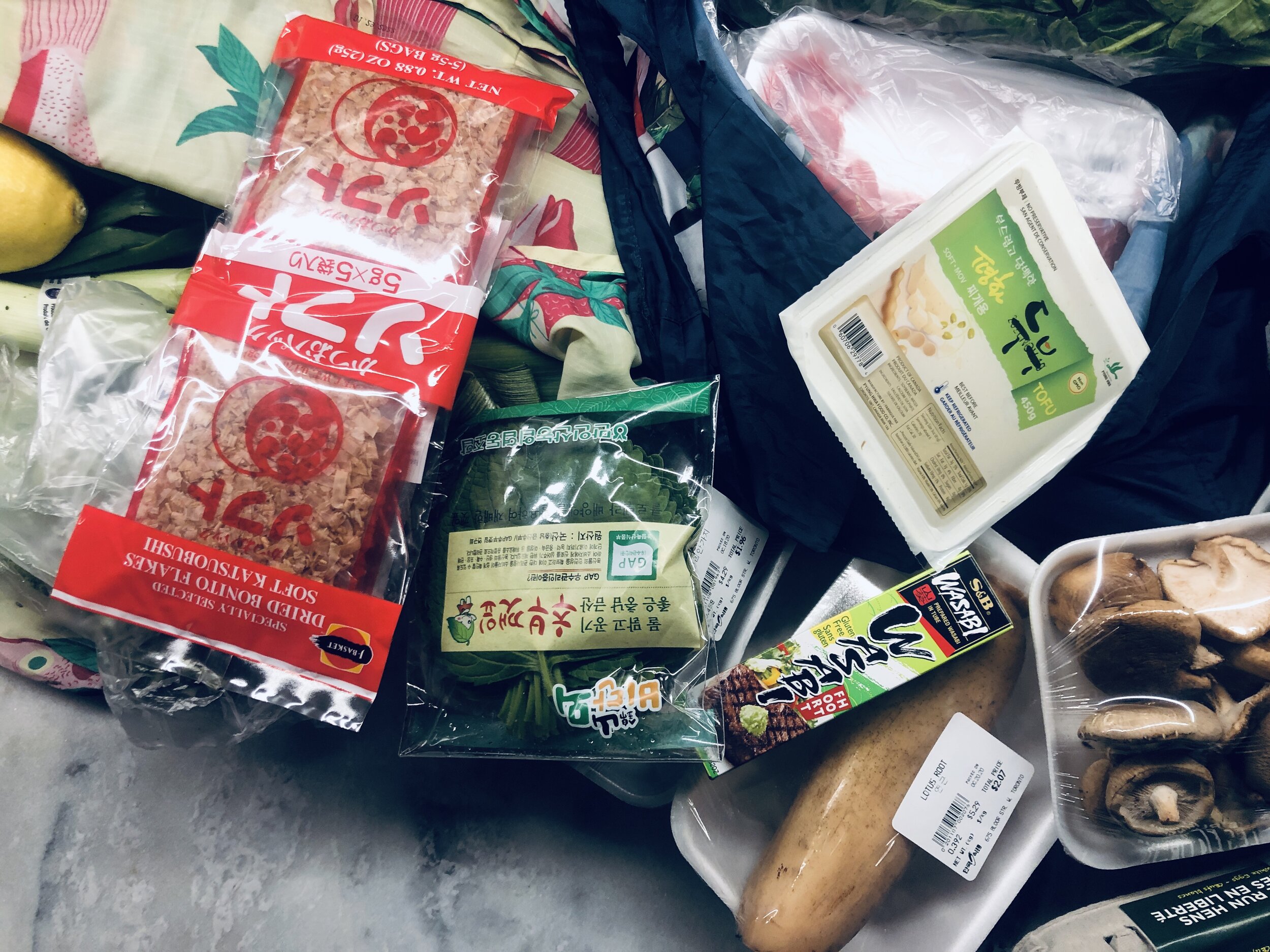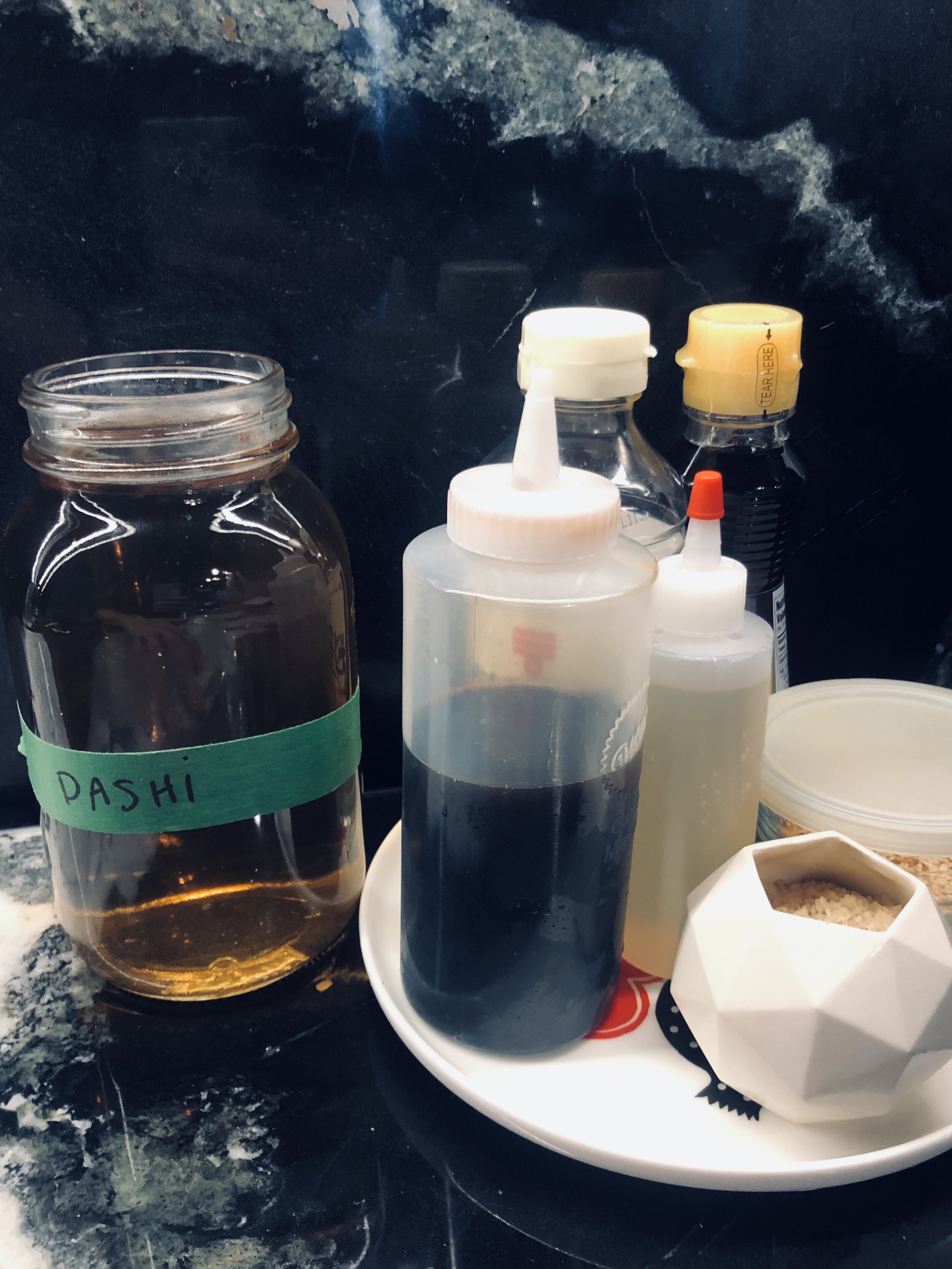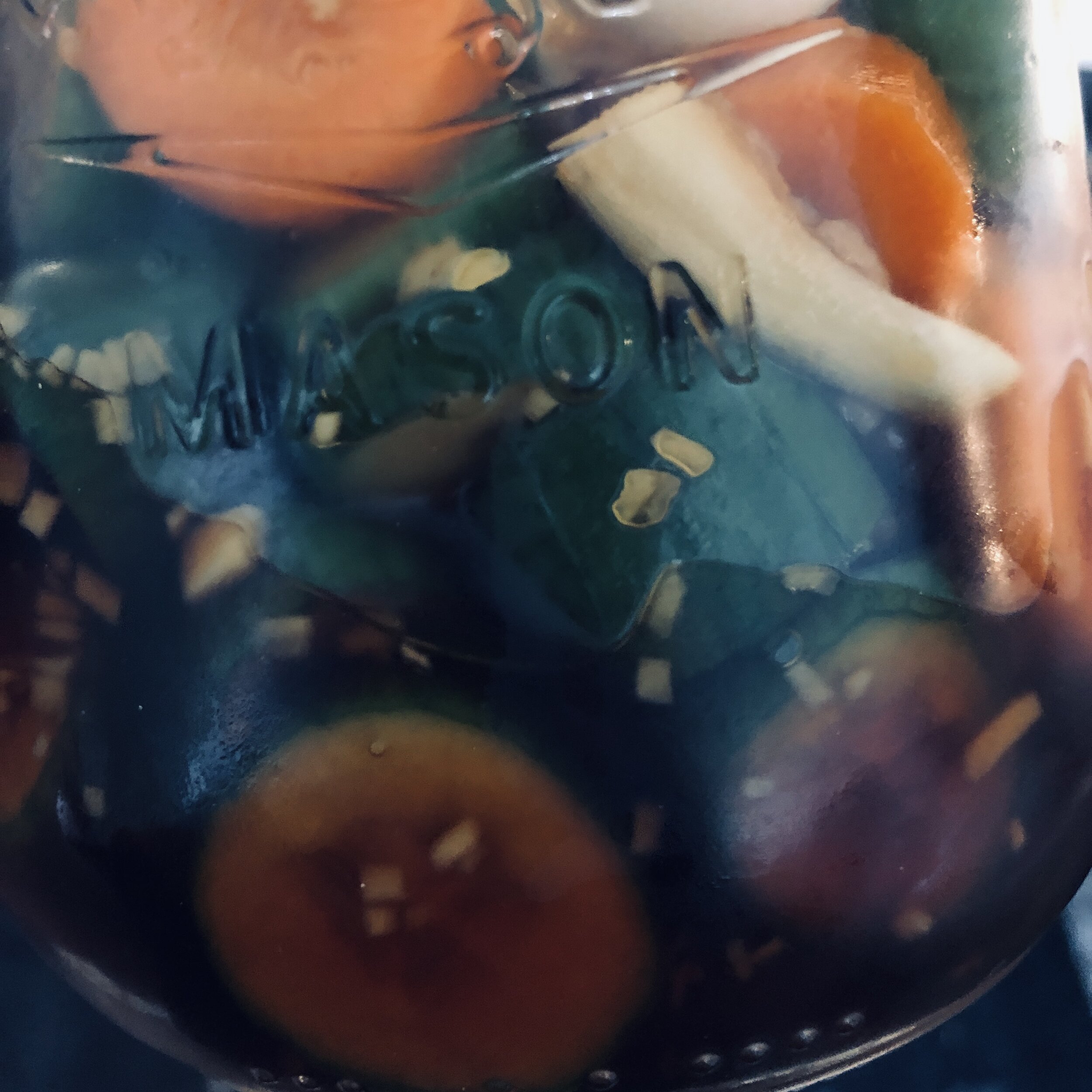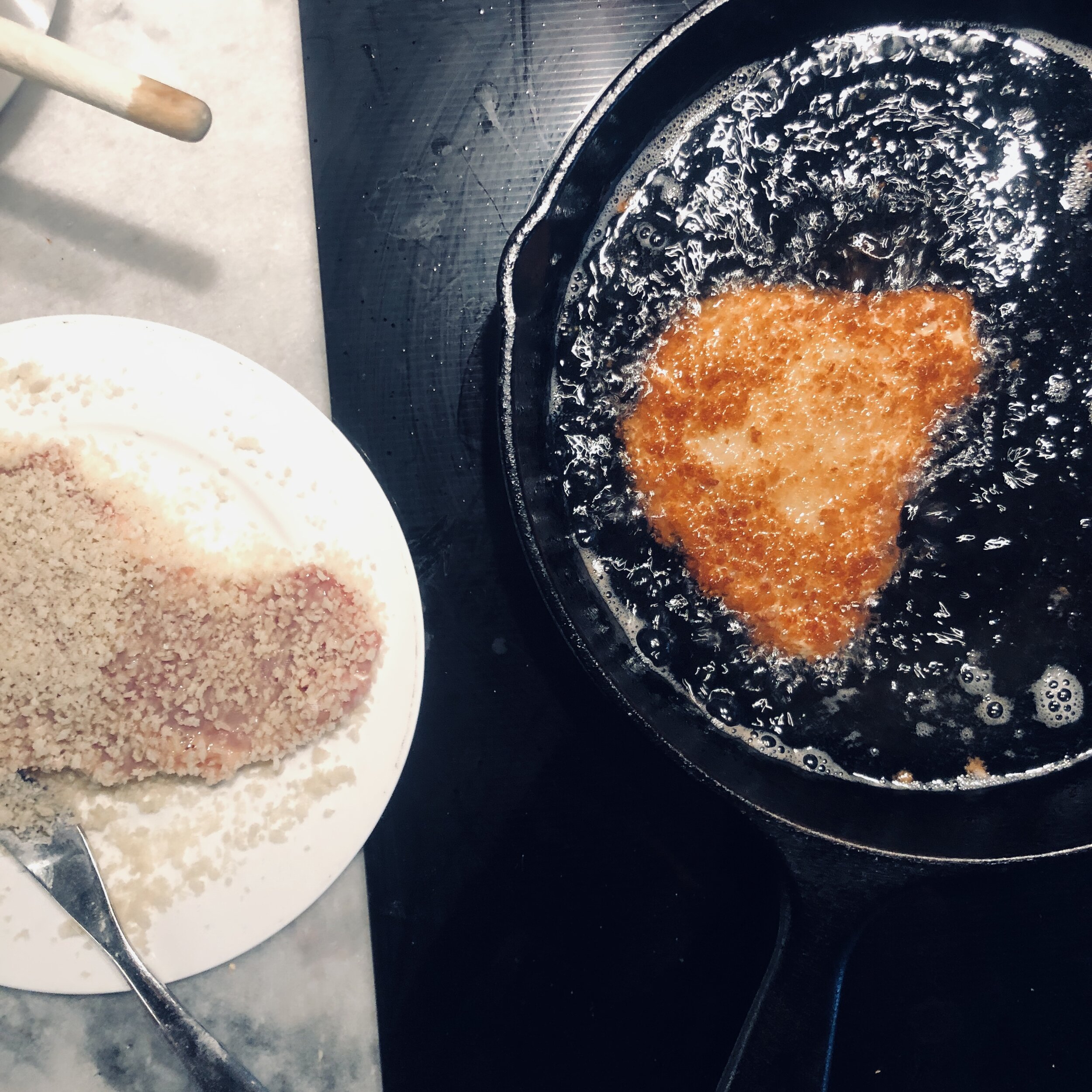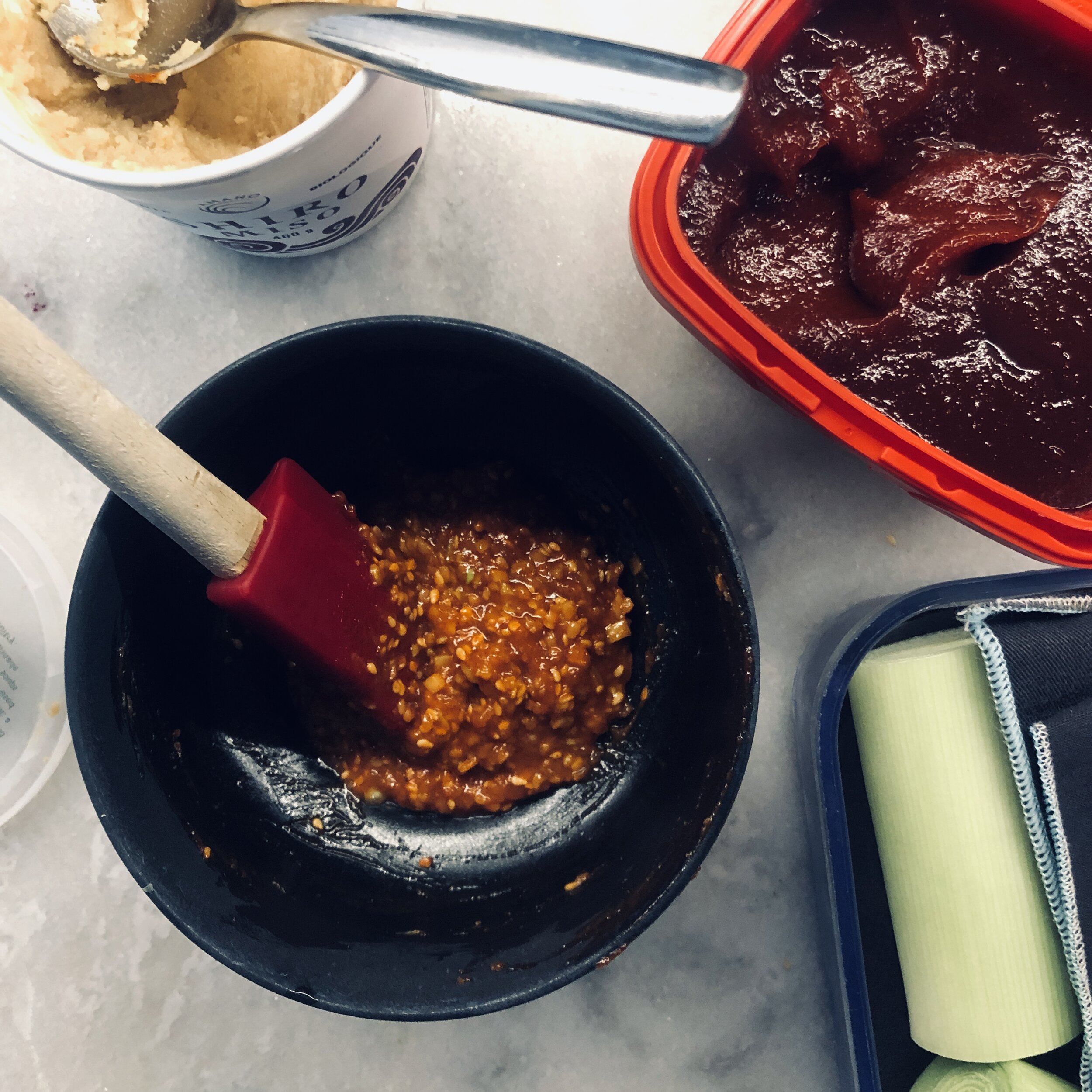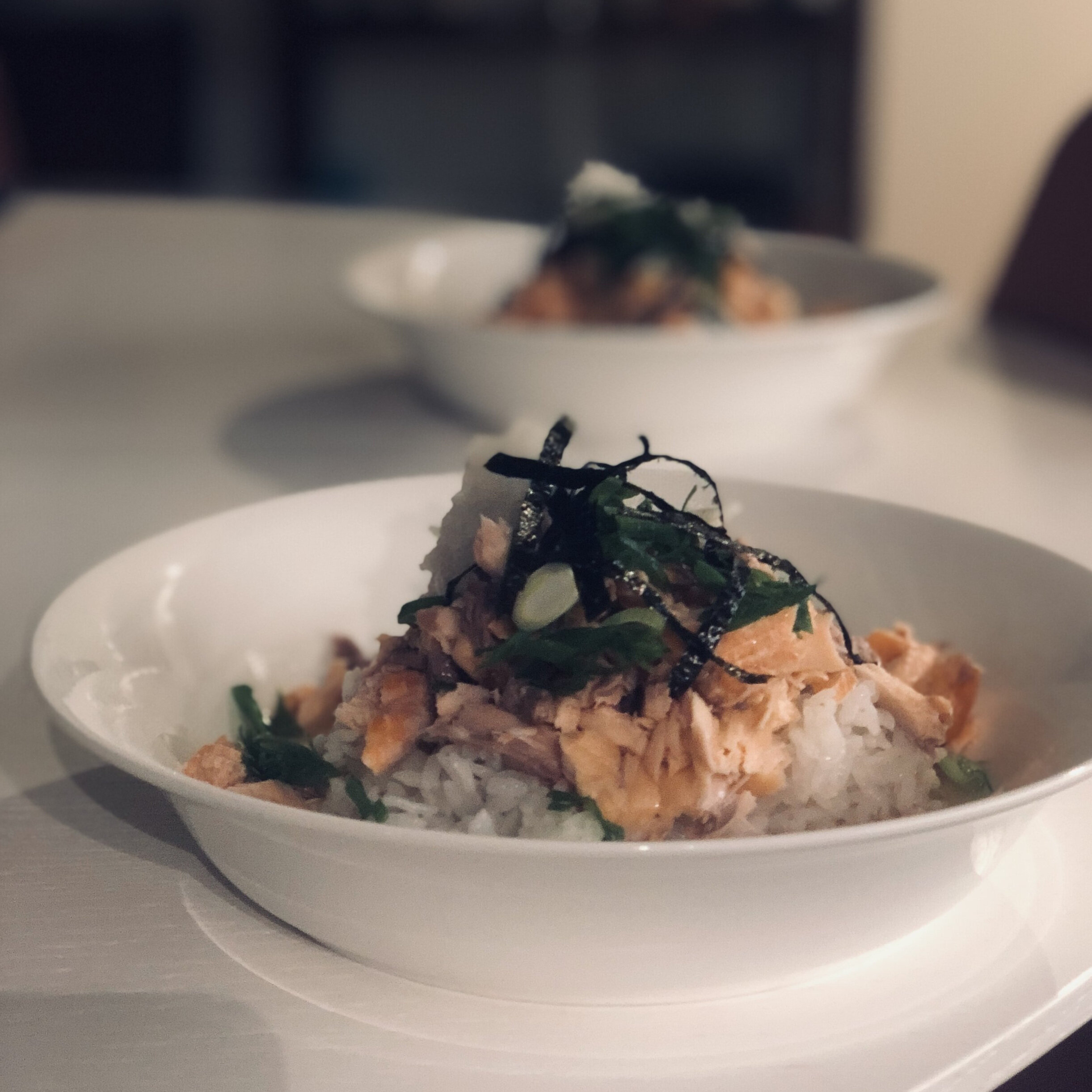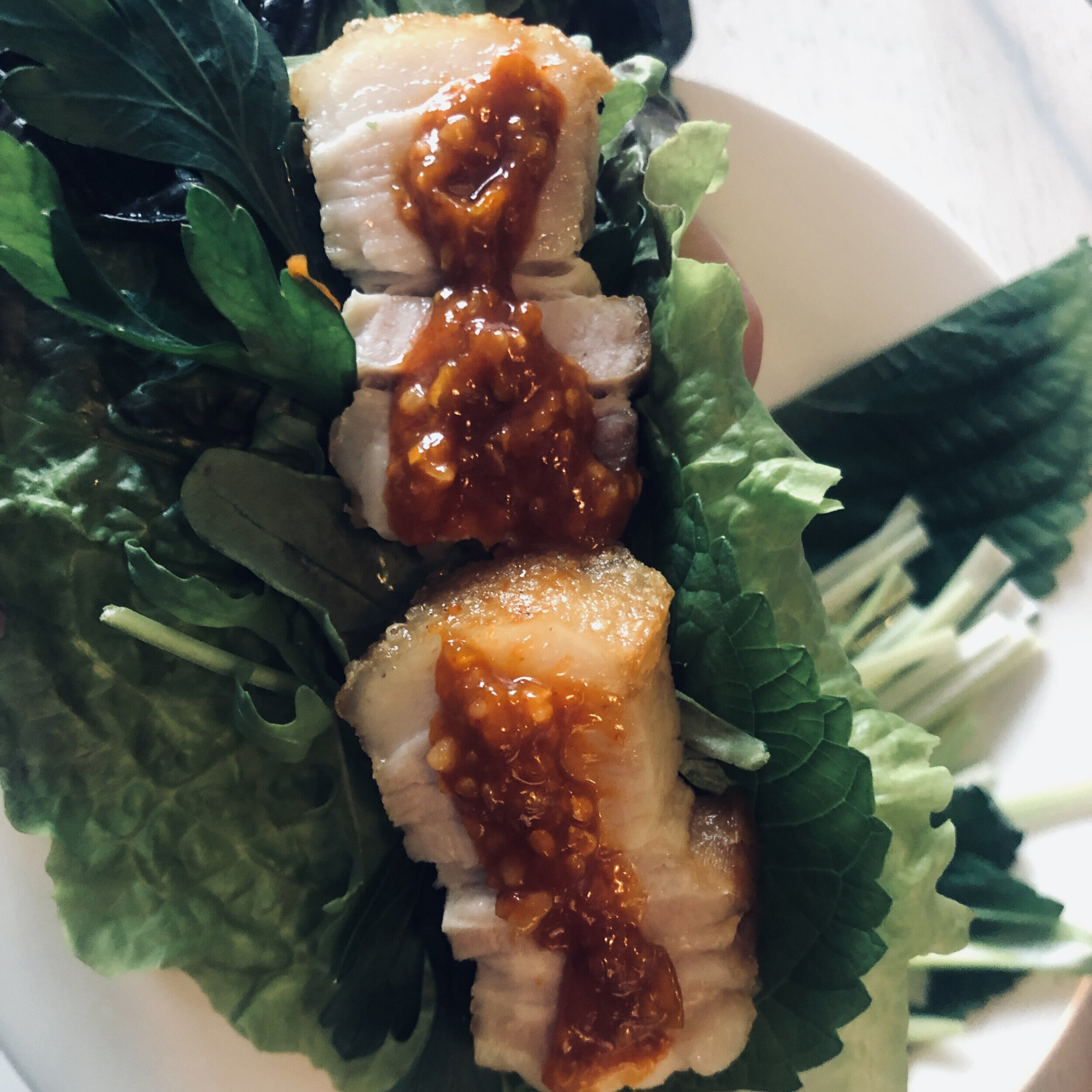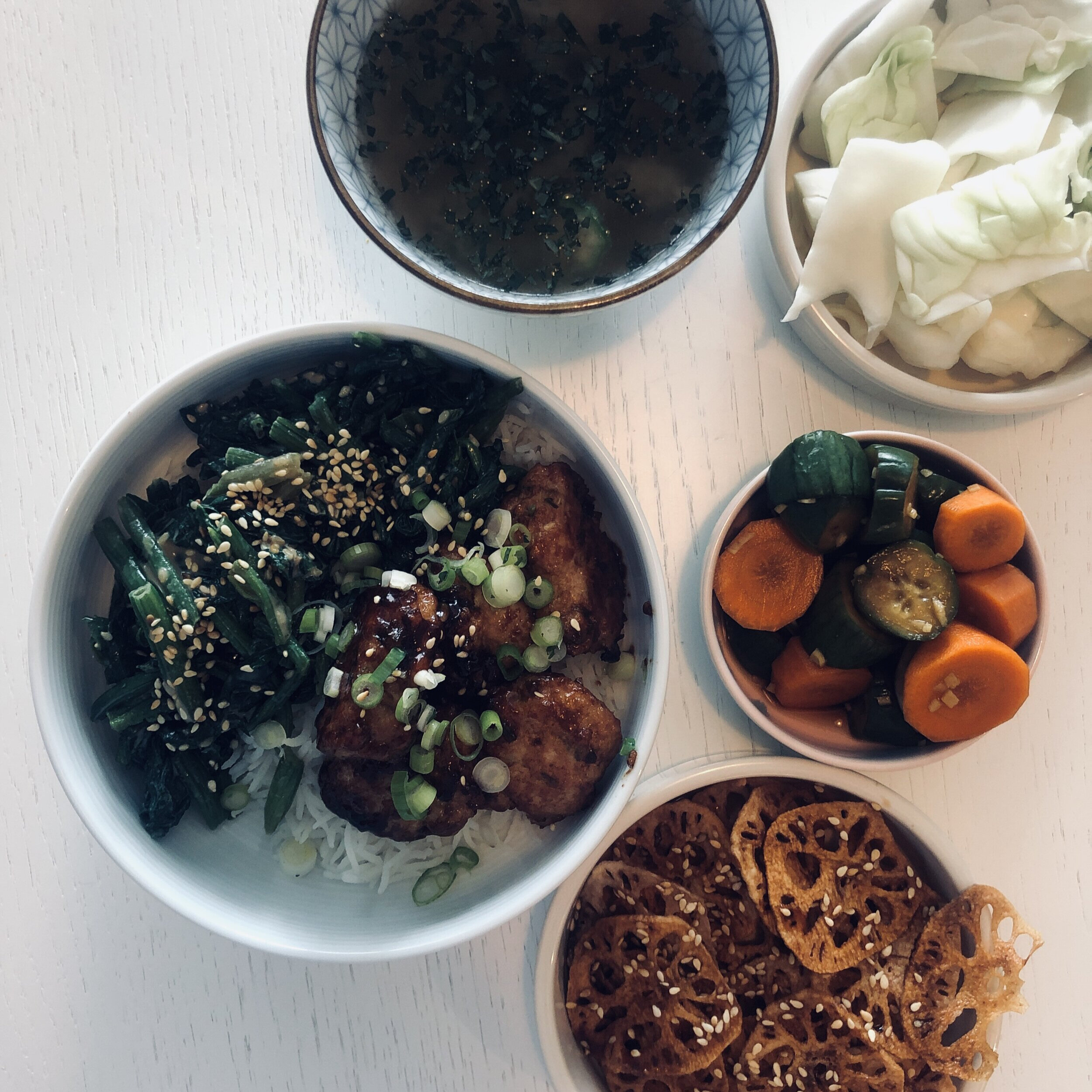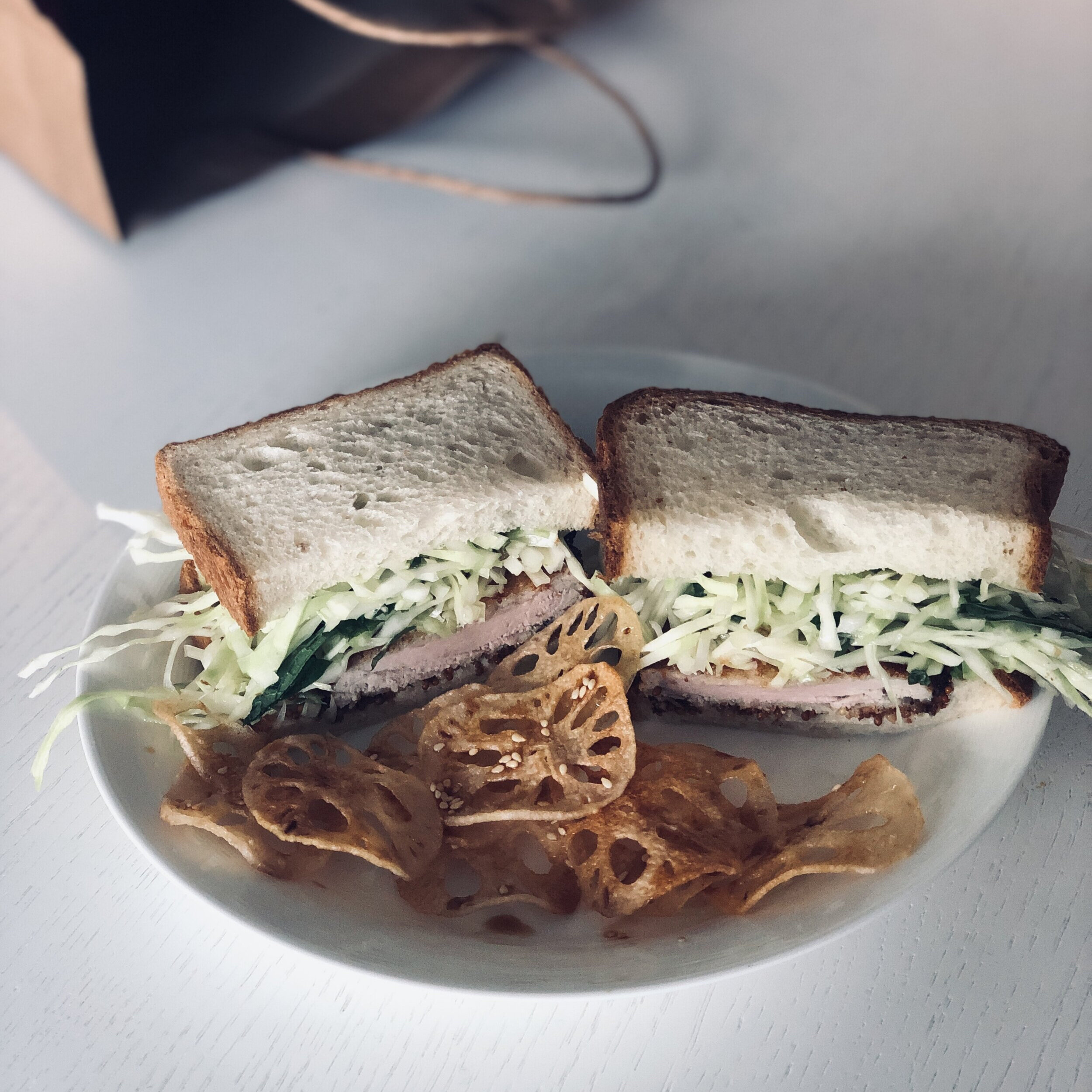
Get ready to join the cult
Tokyo Cult Recipes by Maori Murota
I don’t remember where I got this book but I can definitely picture myself swooning over the bright salmon cover laced with gold foil. Look, I’m not pretending I can’t be convinced to shell out $60 for a nice spine and a well chosen colour palette. I’m only human after all.
I cooked from this book gently for a couple of years. Yet, to be honest, I never got much past breakfast: marinated salmon, pickled cucumbers, soft boiled eggs in a tangy sauce, fluffy white rice, and rich miso soup. We ate this in the mornings in my house for months. I’ve always wanted to prep from this book because the payoff on prep is enormous and the meals come together in a flash. That breakfast, for example, requires salting the fish overnight, making dashi from bonito flakes, preparing the pickle at the start of the week, and of course remembering to set the rice cooker (ours is a Zojirushi with a timer on it which makes life easier). But really when you wake up to the sound of the rice cooker (and the smell of rice in the kitchen), you’re only 10 minutes away from a breakfast that is warm, delicious, and takes you all the way to lunch. I don’t eat breakfast anymore, so I’m ready to dive deeper into this book and explore its flavours and techniques.
The recipes
Note that I’ve halved most of the recipes from the book to serve 2 people. I am including a bunch of lunch recipes in here because these meals come together so quickly and because we’re all working at home right now, and because there is a voice in my head (that sounds like my husband) saying “bentooooo booooxxesss” of which there is a whole section. You may feel inclined to go out and pick up a bunch of cute little dishes to serve things in, and I’m not here to stop you.
Pickles and toppings
Cucumber & carrot tsukemono
Chinese cabbage tsukemono
Lotus root chips
Soups
White miso soup with Daikon
White miso soup with chinese cabbage
Red miso soup with okra & shiso
Niku udon
Lunches
Katsu sando
Spinach with sesame sauce
Tsukune
Deep-fried lotus root with sesame seeds
Katsudon bento
Dinners
Sake Chazuke
Chicken meatball hotpot
Shiobuta with spicy miso sauce
Somen
Desserts
Yuzu sorbet
Shopping list
I hope you might have a bunch of these sauces and vinegars. Some ingredients require a trip to the japanese grocer but if you can’t find something, make a smart substitution or use what you have. For example, if you can’t find yuzu juice then use a lime. If you can’t find shiso, use mint or thai basil.
Vegetables
Small eggplant (1)
Okra (10 or so)
Mini cucumbers (6)
Carrot (1)
Spring onions (2 bunches)
Napa cabbage
Lemons (3-4)
Spinach
Garlic
Onion
Ginger
Red leaf lettuce
Lotus root
Leek (2-3)
Shiitake mushrooms
Sorrel (small bunch)
Arugula (1 handful)
Daikon (1 small)
Meat & dairy
200g pork loin or collar
375g ground chicken
1 8oz salmon fillet*
250g pork belly
Eggs
*I actually chose not to have the salmon dish as the first meal, and so I waited to purchase it until later in the week
Herbs
Shiso (10-12 leaves)
Mint
Coriander
Nira (garlic chives)
Pantry
Raw (demerara) sugar
Somen noodles
Sandwich bread
Flour
Panko
Cornstarch
Japanese rice
Gelatin sheets
Seaweeds
Kombu
Nori
Spices & other
Shichimi togarashi
Wasabi
Tofu (200g)
Red and/or white miso
Katsuoboshi (bonito flakes)
Sake
Umeshu
Sesame seeds
Yuzu kosho
Sauces, oils, & vinegars
Mustard
Mayonnaise
Tonkatsu sauce
Tahini
Oyster sauce
Gochujang
Rice vinegar
Mirin
Soy sauce
Sesame oil
Sunflower oil
Local Toronto Sake from Izumi
Prep
The day before
5 mins
Start the dashi
Place 2l water in a saucepan. Cut 20g kombu into 2 pieces and add to the water. Leave this to soak in the refrigerator overnight. Dashi is the base of a lot of the meals and you may have to make a second batch this week.
Mise en place
15 mins
Take the following bottles out and put them in a bin that fits in your fridge: soy sauce, mirin, rice vinegar, a small bowl of demerara sugar, sake, sesame oil. You’ll be using these in some combination for almost every recipe, so it will make your life easier if you can just pull it out all at once.
Clean the spring onions and chop of the roots and any wilted ends. Finely chop one spring onion. Cut the rest in half and wrap them in paper towel. Store in a resealable bag.
Cut the pork neck (collar) into 4 slices about 2cm thick, pat dry and store between sheets of wax paper.
Toast ½ cup sesame seeds and put in your fridge bin with the soy sauce, etc.
Salt the salmon fillet on both sides, cover with plastic wrap, and store in the fridge. (Note: I actually chose not to have the salmon dish as the first meal, and so I waited to purchase and salt the salmon until later in the week)
Wash the lettuce and herbs and store between paper towels.
Brush the shiitakes to clean them and store them in a cool dry place.
Wash the leeks, cut off the greens and the ends and store the white parts in a paper towel lined container.
Start cooking
3 hours
Make the dashi
Heat water and kombu on a low heat until it just comes to a simmer (about 15 minutes). Don’t let it boil. Take out the kombu just before the stock comes to a boil and add 20g katsuoboshi all at once. Bring to a boil on medium heat, then turn off the head immediately. Let it infuse for 10 minutes. Strain the dashi into a bowl, pressingly lightly.
Make the yuzu sorbet
Soak 15g gelatin sheet in a bowl of water for 20 minutes. Put 100g sugar and 300ml water in a saucepan. Heat on medium until the sugar dissolves. Remove from the heat and add the squeezed out gelatin, 100ml yuzu juice, 2 ½ umeshu, and 50g honey. Either use an ice cream maker, or pour the mixture into a metal container and freeze for 3 hours, breaking up the ice crystals with a fork every 3 hours.
Make the chinese cabbage tsukemono
Cut ¼ chinese cabbage crosswise into thirds, then lengthwise into 4cm pieces. Cut 4 cm kombu into 2cm squares. Peel 2-3 cm ginger and then slice very thinly. Cut the zest of ½ lemon into very thin strips and squeeze its juice. Place everything in a resealable bag and eliminate any air. Seal the bag and massage it from the outside. Store in the fridge.
Make the cucumber and carrot tsukemono
Cut 3 mini cucumbers into bite sized triangular chunks and place in a bowl. Combine with 1 tsp salt and leave for 10 minutes to draw out the liquid. Cut 1 carrot into similar sized pieces and add to the bowl. Combine 3 tbsp soy sauce, 3 tbsp rice vinegar, 1 tsp of sugar, 1 crushed garlic clove, and 1 cm ginger finely chopped in a glass or ceramic container and then add the cucumber and the carrot. Store in the fridge.
Fry tonkatsu
Place 4 tbsp all-purpose flour, 2 eggs, beaten, and 50g panko in separate bowls. Dip the pork first in the flour, then in the egg, then in the panko. Press the panko onto the meat with your hands so it sticks well. Gently remove any excess. Take a frying pan that is large enough to fit all the pieces of pork in a single layer (or cook in 2 batches). Pour in 2cm vegetable oil and heat to 170˚C. Add the pork and cook about 3 minutes on each side until golden. Drain on paper towel and let it cool completely. Once it is absolutely completely cooled, store with fresh paper towel in an air tight container.
Make the hourenso no goma ae (spinach in sesame sauce)
Blanch 150g spinach, leaves and stems in boiling salted water for barely one minute. rain, and when it is cool enough to handle, squeeze out the excess water. Cut the spinach into 3cm lengths. Combine 1 tbsp soy sauce, 1 tsp demerara sugar, 1 tbsp tahini, and 1 tsp toasted sesame seeds in a bowl and then add the spinach. Store in the fridge.
Mix up chicken meatballs for bentos
Combine 1 ¼ tbsp soy sauce, 1 ¼ tbsp mirin, ½ tbsp sugar, ½ tbsp oyster sauce, one bruised garlic clove in a small bowl. Label and store the sauce in the refrigerator. Put 200g ground chicken, 1 finely chopped spring onion, and 1 cm grated ginger in a large bowl and knead together well until the mixture is smooth and even. Add ½ tbsp soy sauce, ½ tbsp mirin, ½ tsp sesame oil and ¼ of an egg(!) and mix well. Pack mixture into a container, cover with a piece of plastic wrap and press down to remove any air. Put a cover on the chicken and store. Label as “tsukene.”
More chicken meatball mix but for the hotpot
Combine 175g ground chicken, ½ egg, 1 tbsp potato starch, ¼ onion very finely chopped, 1cm ginger finely chopped, ½ tsp soy sauce, and some fresh ground pepper in a bowl and mix well. Store in the same way as the other meatball mix. Label as “hotpot.”
Salt your pork
Rub 250g pork belly with 8g coarse sea salt and wrap tightly in plastic wrap. Store in the fridge.
Make the spicy miso sauce
Mix together: 1 tbsp miso, ½ tbsp gochujang, ½ tbsp demerara sugar, ½ tsp soy sauce, ½ tbsp sesame seeds, ½ tsp chopped ginger, ¼ ginger clove, graded, and 1½ cm leek (white part), chopped.
Make the mentsuyu sauce
Place the following ingredients in a saucepan on a low heat: 200ml water, 75ml mirin, 100ml soy sauce, ½ tsp demerara sugar, ½ handful katsuoboshi, and 2½ cm square kombu. Cook for 20 minutes, then remove from the heat. Strain.
Cook the eggplant
Cut the eggplant into 3 lengthwise, then into 6mm thick slices. Heat ½ tbsp sesame oil in a saucepan and saute the eggplant until golden. Add the mentsuyu sauce. Simmer for 5 minutes on medium. Take off the heat and allow to cool. Store in the refrigerator.
No such thing as too many pickled cucumbers: I tripled (!) the recipe because I know my we will be in the fridge all week taking sneaky bites. Tip: You can reuse the pickling liquid by just adding in more cucumber throughout the week.
Umami bomb: spicy miso sauce
Meals
Meal 1:
Sake Chazuke
Rice with green tea and grilled salmon
Put on 1 cup of rice in your rice cooker. When it’s almost ready, take out the salmon fillets and either sear them on a grill pan or bake for 10 minutes in a preheated 180˚C oven. Flake the salmon and season with more salt if necessary.
Place some cooked rice in 2 bowls. Arrange salmon, 1 tbsp grated daikon, and ½ sheet of shredded nori over the rice.
Infuse 1.5 tbsp green tea in 150ml boiling water for 2-3 minutes, then pour over the bowls and eat right away.
Meal 2:
Tori Dango Nabe
Chicken meatball hotpot
Cut the white part of half a leek in 2cm slices on the diagonal. Cut some nira (half a bunch) in half lengthwise. Remove the stems from 6 shiitake mushrooms. Cut 200g tofu into 3cm cubes. Place some washed sorrel and arugula on a plate.
Place 600ml dashi, a 2cm x 2cm piece of kombu, 50ml of sake, 1 tbsp mirin, 1 tbsp soy sauce and a small pinch of salt in a pot with a lid and heat on medium heat. When it comes to a boil, remove the kombu. Add the tofu, leeks, and shiitake. Form the chicken you prepped into meatballs using two spoons and drop into the broth. Cover and cook the meatballs for 5 minutes. Once they are cooked, they will rise to the surface.
While they’re cooking, mix together a sauce 2 tbsp soy sauce, 1 tbsp rice vinegar, and squeeze of yuzu juice.
Take the pot directly to the table and add ¼ of a head of lettuce leaves. Serve with thinly sliced spring onions, shichimi, and yuzu koshou. Give each person a bowl to serve themselves out of the pot, and garnish, and add a bit of sauce if they/you like.
Meal 3:
Shiobuta with spicy miso sauce
Salted pork with spicy miso sauce
Place the salted pork belly in a saucepan. Cover with water and add a 3cm x 1.5cm piece of kombu. Place on medium heat, and once it comes to a boil, cook on low heat for 1 hour. Turn off the heat and let the pork cool in the cooking liquid. When it’s lukewarm, take it out and slice into 1cm thick slices.
Take the sauce out of the fridge and bring to room temperature. Cut 1.5 cm of leek (white part)into very thin matchsticks. place the slices of pork on a plate with some lettuce leaves, shiso leaves, cilantro, mint, nira, or whatever other herbs you have around. Eat by building a little wrap with the pork and veggies and dress with the sauce. If you have some leftover rice you can add this to the roll as well.
Meal 4:
Somen
Fresh noodles with sauce and toppings
Take the eggplant and mentsuyu sauce out of the fridge and bring to room temperature. For the toppings, scramble 2 eggs with a small pinch raw sugar. Cut 1 mini cucumber into matchsticks. Cook 4 okra for one minute in boiling water and then slice thinly. Slice 1 spring onion finely and shred 1/4 sheet nori. Grate 1.5 cm ginger. Put all the toppings and some toasted sesame seeds in separate little bowls to serve.
Cook the 200g somen noodles just before serving. They need to be fresh or they won’t have the right texture. Bring a large saucepan of water to boil and cook the noodles according to the package instructions. Drain and rinse the noodles, rubbing them together under running water for 1 minute to completely remove the starch. This step is compulsory!
Arrange the noodles in a large “zaru” bamboo basket on a plate if you have it or on a plate if not. Place a few ice cubes on the noodles to chill them. Dilute the mentsuyu sauce to taste, to start, try about 30% of the sauce volume in water, split between two bowls and serve. To eat, put your choice of toppings in your bowl, dip the noodles and eat.
Chicken hot pot: this photo is great excuse to get a Donabe.
I pre-cooked the pork belly and stored it in the fridge. To warm it up, I pan seared the outsides and got a beautiful crispy crust on the skin
Lunches
Lunch 1:
Meat Bento
Cook 1 cup rice in a rice cooker. Take 2 pieces pre-fried tonkatsu out of the fridge and put on the counter. Slice 1 mini cucumber thinly on the diagonal. Put it in a bowl with 2 tsp salt, a 2 cm piece kombu, and a couple of thin slices of ginger sliced into matchsticks. Preheat your oven to 220˚C broil with a baking sheet inside on the top rack. Put the tonkatsu in the oven and check after 4 minutes. Flip when the first side is crispy. Even better if you use a toaster oven. While the pork is heating up, break 4 eggs into a bowl and mix. Peel and cut ½ onion in 5mm slices. Slice the tonkatsu into 2cm strips.
Add 100ml dashi and the onion to a frying pan that will fit your tonkatsu in one layer. Bring to a boil on medium heat. Add 4 tsp mirin, and 2 tbsp soy sauce and cook until the onion is tender. Add the pieces of tonkatsu and cook for another 2 minutes, then add the egg. Once the egg starts to set, cover the pan and cook for another 30 seconds. Remove from the heat but leave the lid on for a few minutes to let the eggs finish cooking.
Serve the omelette and cucumbers on a bed of rice and sprinkle the eggs with shichimi.
Lunch 2:
Hanami Bento
Cook one 1 cup rice. Make a bento by adding rice and whichever toppings you like:
Spinach with sesame sauce
Take the spinach with sesame sauce out of the fridge and let it come to room temperature.
Tsukene
Take the sauce and chicken meatball mix out of the fridge. Roll chicken into balls that are 3-4cm in diameter. Heat sunflower oil to 2cm depth in a frying pan. Add the meatballs and cook on medium until browned on one side. Turn them over, cover the pan, and leave them to cook through to the center. Add the sauce to the pan and cook until smooth and thick. Careful not to burn. Remove the garlic.
Pickled cabbage and/or pickled cucumber
Deep-fried lotus root with sesame seeds
Peel and halve 6cm lotus root, then slice into 6mm pieces. Soak in water for 5 minutes, then drain. Dry on paper towels. In a small saucepan heat 2cm of sunflower oil to 170˚C. Deep-fry the lotus root until they are nice and golden. Drain and combine with 1 tbsp soy sauce and 1 tbsp sesame seeds.
Eat while contemplating the beauty of cherry blossoms.
Lunch 3:
Katsu sando
Breaded pork sandwich
Take 2 pieces of the pre-fried tonkatsu out of the fridge and put on the counter to bring to room temperature. Preheat your oven to 220˚C broil with a baking sheet inside on the top rack. Put the tonkatsu in the oven and check after 4 minutes. Flip when the first side is crispy. Even better if you use a toaster oven.
While the tonkatsu crisps up, make the coleslaw: use a mandoline to thinly slice ⅛ cabbage. Finely chop a few herbs such as shiso, mint, and coriander. Combine the cabbage and herbs with ½ tbsp olive oil, a squeeze of lemon, and a pinch of salt. Leave it marinate for 5 minutes.
Toast 4 slices of sandwich bread. Spread them with whole grain mustard and mayonnaise. Then, build the sandwich in this order: some sliced cucumber, the tonkatsu, ½ tbsp of tonkatsu sauce, and half the slaw.
Miso soups to go with your lunch:
Daikon
Slice 2cm daikon into 3mm rounds and then into thin matchsticks. Add to 300ml dashi brought to a boil and cook on medium for 3 minutes. Add 2 tbsp white miso.
Chinese cabbage
Cut 2 leaves of cabbage into three pieces and then into 6mm strips. Cut 1/2 cm ginger into thin matchsticks. Boil 300ml dashi, add cabbage and cook on medium for 5 minutes. Add ginger and 2 tbsp white miso.
Okra and Shiso
Cut 3 okra into 3mm slices. Bring 300ml dashi to a boil, add the okra, and cook for about 1 minute. Stir in 2 tbsp miso, then remove from the heat and serve. Sprinkle with 1 shiso leaf, very finely shredded.
I forgot to get onions (how is that possible?) so I used a leek instead with great result.
Lessons & leftovers
A lot of these ingredients are difficult to buy in moderation: tofu, daikon, lotus root, cabbage, shiso, okra, katsuobushi, kombu, and shiitake were all leftover at the end of the week. I lucked out finding a daikon that was broken in half, otherwise I wouldn’t have been able to carry home the ones that were for sale at PAT. Go for another round of the chicken hotpot (leaving out the chicken) or somen noodles (with or without the eggplant). You can also make onigiri (p.94-98) which is a great use for leftovers, especially the shiso and shiitake. With the cabbage I’m making okonomiyaki for lunch and yakisoba. You can also make grilled shiitakes (p.170), furofuki daikon (p.158), hotate salad (p.154 , which I’m craving while thinking about the scallop roll at KazuNori), and of course, fried lotus root with every meal! And for those bags of katsuobushi and kombu, you can now make dashi whenever you need it. Refer back to those miso soups above. You can add noodles, tofu, and a bit of rich sauce to any of those too to make a delicious soup for lunch. Remember you have a great repertoire now of flavours and sauces that you can use with any of these ingredients.
Things like soy sauce, udon, rice vinegar, or mirin are massively marked up at mainstream grocery stores. You’ll spend half as much, easily, if you get acquainted with your local Japanese or Korean store. PAT supermarket in Toronto has a great selection with beautiful produce and high quality meat.

